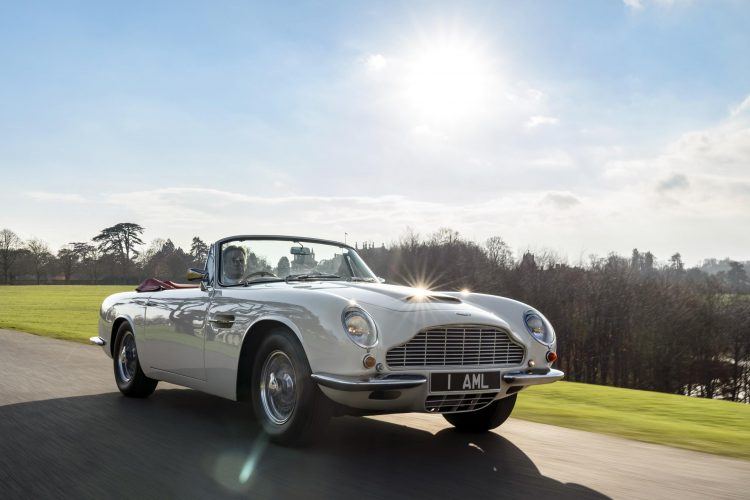- Take your favorite classic car and fit it with a modern EV powertrain.
- That’s exactly what Aston Martin has done with a 1970 DB6 MkII Volante.
- The reversible “cassette” powertrain concept is still sympathetic to the original car.
- Aston Martin’s Heritage models are now part of their overall electrification strategy.
Here’s a lovely idea, and I mean that both figuratively as well as literally. Take a cool old car, in this case an Aston Martin 1970 DB6 MkII Volante, take out the old drivetrain, and replace it with a completely new electric one. Not only is it an interesting engineering exercise, but a much more elegant EV than anything else currently on the road.
Aston Martin isn’t the first car company to do this. Jaguar produced a limited run of E-Types that were converted over to EVs. Meghan Markle and Prince Harry drove one from their wedding to the reception.
So, if anything, that shows you can teach an old dog new EV tricks.
Side A & Side B
Created as part of Aston’s wider EV strategy, this electric DB6, part of the Heritage electrification concept, was developed in-house at the Newport Pagnell Works. It is built around a so-called “cassette” EV powertrain, meaning all the electrical stuff “plugs in” to where the old ICE stuff used to. Since it’s nearly a plug-and-play deal, you can take out all the EV gear and put back that silky, smooth straight six vintage Astons are known for. In other words, Aston Martin has future-proofed these exquisite machines by creating the world’s first reversible EV powertrain conversion.
Aston Martin started this project during the final development phase of the Rapide E, the EV version of their four door luxo sedan. Work on the Rapide E also dovetailed into planning for the new range of Lagondas, as well as the Aston Martin Works’ Heritage EV conversions.
By using this approach, Aston really thinks they’re on to something.
@astonmartin shows us you can teach an old dog new EV tricks.
Click To Tweet

The Aston Martin Works’ Heritage EV conversion program employs an “EV cassette” and key components from the Rapide E platform. Aston Martin says the car’s original integrity will remain, despite a modern EV powertrain. Photo: Aston Martin The Americas.
First Recorded Version
A 1970 DB6 MkII Volante, first hand-crafted at Newport Pagnell, is the first to receive the new cassette system, although the original engine and gearbox mountings are still in place. Enclosed within its own self-contained cell, umbilical cords from the power unit feed the car’s various electrical systems. Power management (i.e. how much juice and range you have) is taken and monitored through a new screen in the cockpit.
However, since this is not just an Aston Martin, but a vintage Aston Martin, that screen is “discreetly fitted to the car’s interior.”
Contemporary Yet Vintage
Aston was very picky, meaning the EV conversion should support the integrity of the original car. Aston Martin feels this trick cassette system offers the perfect solution, future-proofing the car in a socially responsible way, yet still being a genuine Aston Martin; with the option of returning its original powertrain if preferred.
Given the historical significance of these collector cars, it’s hard to argue with this philosophy.
And yes, in case you’re interested (and have the cash) this is most definitely not a one off. Now that they are done with this proof-of-concept DB6 Volante, Aston Martin Works’ will move forward with more customer Heritage EV conversions. They are expected to start sometime in 2019.
Negative Energy
There are, of course, downsides to this. Cost is the first one. Any Aston Martin is not cheap, especially old ones, and future cars like this DB6 Volante will likely cost you a pretty penny. The other downside is that even though this is an electric vehicle, it was not designed and built around where battery packs would go.
So the number of batteries, and hence, the all up range of these things, probably won’t be as good as a car designed from the ground up as an EV.
Positive Vibes
The real upside, though, is that if Aston Martin can do this, so could other car companies. I have long advocated this. Take the early 60s Kennedy Continentals. Big, massive, stylish – the perfect candidate for going with a full EV conversion. The trunks are huge (for a start). You can easily fit four Jimmy Hoffas in there. If you line the floor with batteries, you’d still have lots of room left over.
Weight? Who cares! Stock those things weigh two-and-a-half tons, so how bad could adding a slew of batteries make it. And throw some up in that yawning engine bay while you’re at it. Electric motors don’t take up much space, right?
Now Imagine This . . .
If it were up to me, every car company worth its steel would be doing this. Imagine roads with EV Chevy Nomads and shoebox Fords, Chrysler Imperials, and Jag Mark 2s – only EVs! Silently wooshing down our streets and being demonstrably better cars than Nissan Leafs on class alone.
Until then, all I can say is thank you Aston Martin.
Tony Borroz has spent his entire life racing antique and sports cars. He is the author of Bricks & Bones: The Endearing Legacy and Nitty-Gritty Phenomenon of The Indy 500, available in paperback or Kindle format. Follow his work on Twitter: @TonyBorroz.
Aston Martin Heritage EV Concept Gallery












Photos & Source: Aston Martin The Americas.
https://www.automoblog.net/2018/12/12/aston-martin-ev/


No comments:
Post a Comment